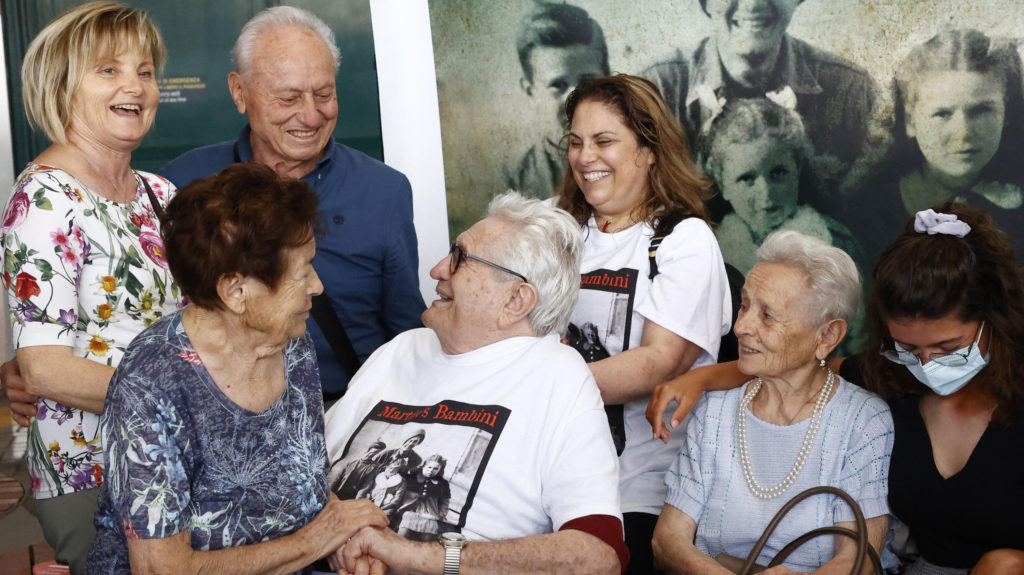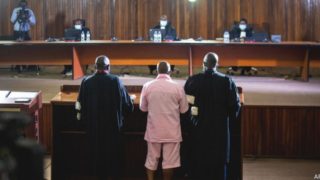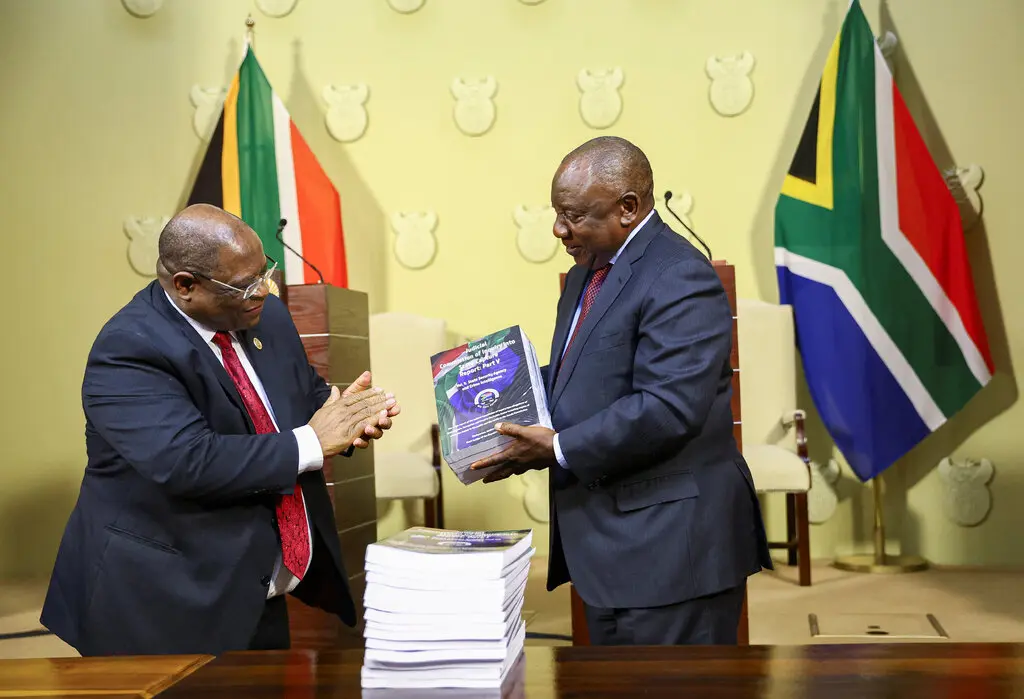BOLOGNA, Italy — The last time Martin Adler saw the three Naldi siblings in person, it was during World War II in the central Italian village of Cassano di Monterenzio, some 40 kilometers south of Bologna, during an Allied offensive.
Searching door-to-door for German soldiers in October, 1944, Mr. Adler, then a 20-year-old American private, and another soldier stumbled upon a large wicker container covered with a cloth in one house and were about to open fire after seeing it suddenly move.
Mr. Adler hesitated and a woman burst into the room screaming: “bambini, bambini” — “children, children” — and two girls and a boy popped out of what turned out to be a cradle. The two American soldiers lowered their rifles and laughed in relief. A photograph of Mr. Alder with the children immortalized the encounter.
On Monday, Mr. Adler, now 97, and the three Naldi “bambini” — Bruno, 83, Mafalda, 82, and Giuliana, 80 — met in person for the first time in 77 years at the Bologna airport, amid a boisterous scrum of local, national and international media.
Wearing a T-shirt with the photograph of him with the three children, Mr. Adler handed each Naldi a chocolate bar and said: “Bambini.” (If the Naldis, now grandparents and great-grandparents, objected to being called children, as they repeatedly were on Monday by just about everyone, they were too gracious to say).
“My heart is bursting,” said Mr. Adler. “Grazie, grazie,” he said, blowing kisses in front of a blown-up copy of the 1944 photograph.
“He’s so happy,” said Mr. Adler’s daughter, Rachelle Adler Donley. “I haven’t seen him so happy for so long.
Last November, Ms. Adler Donley posted the photograph of the children with her father on some World War II-themed internet groups, putting into motion the events that led to the reunion Monday.
She had wanted to cheer up her father, who was living in a retirement community in Florida with his wife, Elaine, unable to see friends and family because of the coronavirus.
Finding the children, she hoped, might help him out of his slump.
Mr. Adler didn’t talk much about the war, but he did recount that particular incident, she said. “It was the one happy day in a war in which there weren’t many happy days,” she said Monday.
Matteo Incerti, the author of several books about World War II, saw the photo online, and tracked down the position of Mr. Adler’s company, the 339th Infantry regiment, in the fall of 1944, along the Gothic Line in the Apennine Mountains.
He asked for help on social media and got local and national media involved. The photo — and the appeal to find the children — was aired on the nightly newscast on Italy’s main public television channel. By a stroke of luck, the daughter of one of the Naldis was watching and recognized them as the children.
Mr. Incerti put them in touch with Mr. Adler in Florida, and they reunited virtually in December, an event that was broadcast on the news show — a feel-good Christmas tale at the tail end of a year when good news had been scarce.
Gianpaolo Di Silvestro, a maker of resin models for collectors and museums, created a miniature of Mr. Adler with a 3-D printer that he hopes to market (alongside Darwin and other figures). “I thought: This is a real superhero,” Mr. Di Silvestro said. “Miniature war scenes are very popular, and I thought why not tell a real story that had a happy ending.”
Mr. Incerti wrote a book about Mr. Adler titled “I bambini del soldato Martin” (Soldier Martin’s Children), based mostly on Mr. Adler’s memories, as well as on cartoons he drew and photographs he took during the final 18 months of World War II. The book also delves into Mr. Adler’s postwar years, when, after receiving a degree in social work and working with veterans, he became director of the Helen Keller National Center for Deaf-Blind Youths and Adults in Sands Point, N.Y.
But Mr. Incerti, too, had never met Mr. Adler in person, and the night before he did, he was so excited he could barely sleep — “three hours, give or take,” he said.
Over the next two weeks, Mr. Adler is to attend several events for Mr. Incerti’s book as he takes part in a nostalgia tour.
He will visit Monterenzio, where he first encountered the children, and receive the keys to the village. He is scheduled to visit the Tuscan Gothic Line Museum, an hour north of Florence, and visit the Neapolitan hospital where he spent three months after being wounded in 1945. And in Rome, he’ll tour the main synagogue, which he visited in 1944, and is expected to meet with the mayor, Virginia Raggi.
“I never thought I’d be back to see the children,” Mr. Adler said a chaotic news conference on Monday, recalling the cruelty of war.
“But democracy is good, and it won the war,” he said. “We all pitched in — France, England, Italia, America — we all beat them.”
Giuliana Naldi got a little teary-eyed.
“It’s been very moving,” she said, noting that she had strategically kept a handkerchief close at hand.
Giuliana is the youngest of the three, but has the most vivid memory of her mother warning the children to hide because soldiers were coming that mid-October day in 1944. They hid in a wicker cradle, she recalled, pulling a cloth over themselves.
Mafalda, who appeared a little overwhelmed by all the attention on Monday, said she was happy to see Mr. Adler, but wondered why reporters kept asking the same questions “over and over again.”
Bruno Naldi was thrilled just to embrace the moment.
“It’s been wonderful,” he said. “He kept the photo for 77 years, he searched for us and found us, and then he came to see us. What a beautiful tale.”
FEATURED IMAGE: Elisabetta Baracchi/EPA, via Shutterstock
By Elisabetta Povoledo/The New York Times






